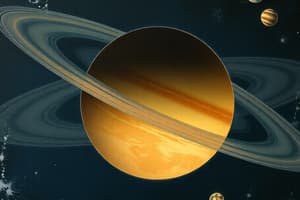Podcast
Questions and Answers
What does Kepler’s 3rd Law express about the relationship between a planet's orbital period and its average distance from the sun?
What does Kepler’s 3rd Law express about the relationship between a planet's orbital period and its average distance from the sun?
- The square of the orbital period is directly proportional to the cube of the average distance. (correct)
- The cube of the orbital period is directly proportional to the square of the average distance.
- The square of the orbital period is inversely proportional to the average distance.
- The orbital period is constant regardless of the average distance.
Which of the following is an effect of Kepler's first law regarding planetary motion?
Which of the following is an effect of Kepler's first law regarding planetary motion?
- All planets orbit the sun at the same distance.
- The distance from the sun to a planet varies as the planet moves in its orbit. (correct)
- Planets do not move in relation to their distance from the sun.
- Planets move in circular orbits at constant speed.
If a planet has an average distance (a) of 4 AU from the sun, what is the orbital period (P) according to Kepler's 3rd Law?
If a planet has an average distance (a) of 4 AU from the sun, what is the orbital period (P) according to Kepler's 3rd Law?
- 8 years (correct)
- 16 years
- 12 years
- 4 years
Which statement correctly describes Kepler's second law?
Which statement correctly describes Kepler's second law?
What is the significance of Kepler's laws in the context of modern science?
What is the significance of Kepler's laws in the context of modern science?
What does the P in Kepler's 3rd Law represent?
What does the P in Kepler's 3rd Law represent?
How does Kepler’s first law affect a planet's speed during its orbit?
How does Kepler’s first law affect a planet's speed during its orbit?
In the equation P² = a³, what does the variable 'a' represent?
In the equation P² = a³, what does the variable 'a' represent?
What does the eccentricity of an orbit measure?
What does the eccentricity of an orbit measure?
Which astronomer did Kepler collaborate with?
Which astronomer did Kepler collaborate with?
What does Kepler's 3rd law (P² = a³) relate to?
What does Kepler's 3rd law (P² = a³) relate to?
Which laws or concepts were necessary to explain Kepler's observations?
Which laws or concepts were necessary to explain Kepler's observations?
How does the orbital period of a planet relate to its distance from the Sun according to Kepler's laws?
How does the orbital period of a planet relate to its distance from the Sun according to Kepler's laws?
Which planet has the most eccentric orbit, influencing its seasonal variability significantly?
Which planet has the most eccentric orbit, influencing its seasonal variability significantly?
What does a perfect circle's orbit possess that differentiates it from an ellipse?
What does a perfect circle's orbit possess that differentiates it from an ellipse?
Why was the P² = a³ formula significant to the heliocentric model?
Why was the P² = a³ formula significant to the heliocentric model?
Flashcards are hidden until you start studying
Study Notes
Kepler's Laws of Planetary Motion
- Kepler's First Law: Planets move in elliptical orbits with the sun at one focus of the ellipse.
- Eccentricity: Measures how stretched or elongated an ellipse is compared to a circle. A perfect circle has an eccentricity of 0, while a more elongated ellipse has a higher eccentricity.
- Effect of Eccentricity: The distance from the Sun to the planet varies as the planet moves in its orbit.
- Kepler's Second Law: A line drawn from a planet to the sun sweeps out equal areas in equal times.
- Effect: When a planet is further from the Sun, it moves more slowly. When the planet is closer to the Sun, it moves faster.
- Kepler's Third Law: The square of the orbital period of a planet is directly proportional to the cube of its average distance from the Sun.
- Formula: P² = a³
- Units: Always use Astronomical Units (AU) for the semi-major axis (a) and years for the orbital period (P).
- Example: If a planet has a semi-major axis of 4 AU, its orbital period is 8 years (P = √a³ = √64 = 8).
- Relevance: This law helps to predict the orbital periods of planets based on their average distances from the Sun.
- Historical Significance of Kepler's Laws:
- Provided solid mathematical proof for the heliocentric model of the solar system.
- Laid the groundwork for Newton's law of gravitation.
- Contributed to a deeper understanding of the universe.
- Notable Planets:
- Mars: Has a more eccentric orbit than other rocky planets, resulting in significant seasonal variability.
Orbital Types
- Circular Orbit: A perfect circle with a constant radius.
- Elliptical Orbit: An elongated orbit with a semi-major axis and a semi-minor axis.
- Hyperbolic Orbit: An open orbit where an object does not continually orbit a celestial body.
Studying That Suits You
Use AI to generate personalized quizzes and flashcards to suit your learning preferences.




